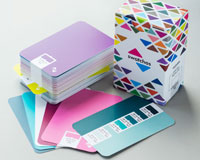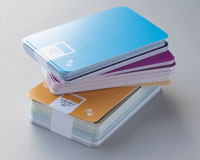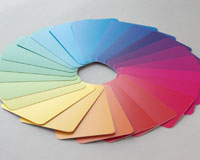for people who design things, then print them
Printer, Designer & Client. Who's responsible for what?
Who's responsible for what?
The Short Answer
Clients, you need to supply text and images that are without fault. And you need to check the text and images of any artwork the designer sends to you.
Designers, you're responsible for submitting correctly prepared artwork to the printer. You are responsible for understanding the printing process well enough to prevent any obvious issues.
Printers, you are responsible for printing, trimming and packing the job to an acceptable level. You are responsible for flagging up any potential issues that are beyond the obvious.
I have attempted to be as unbiased as possible for this article. To even up the fact that I am a designer I asked two printers, Boss Print in London and Print Project in Belfast, to read through this article and give it their approval. I've used both of them and would recommend them to any designer.
Let's begin...
The mistake

I'll admit it, this has happened to me a few times...
A few print samples have come back from the printer. The bulk of the job has gone straight to the client.
You open the envelope and...
“Um, these don't look right. They look really bad. Oh man what on earth happened?”
Then...
“Did I screw that up? Oh no, did I forget to check that PDF?”
Then, whilst frantically hunting for the print ready PDF...
“Oh man, how much did this print job cost again?”
Then a sort of sick feeling comes over you.
I'm not sure you're a proper designer until this moment. You should get a badge or something at this point in your career.
What can go wrong? And who's fault is it?

So, you've found the mistake. What you do next is really important. It's a moment where you'll be judged to be professional or not. It's a moment that can cause a client to really trust in you. And that is a hugely valuable thing.
When a print job doesn't turn out right it's important to find who is at fault. Not so you have someone to blame, but so you can find the best way to sort it. Who is at fault clearly depends on the error. So who is responsible for what?
The client is responsible for...
- Supplying text that is without mistakes.
- Ensuring that any supplied images do not conflict with copyright laws.
- Checking PDF proofs for text errors or incorrect images.
- Making sure any legally required terms & conditions are included and correct.
The designer is responsible for...
- Checking printer proofs (PDF or printed) for artwork issues.
- Setting up artwork so text is legible.
- Using images at a high enough resolution (usually 300dpi), unless stated and clarified with client and agreed upon.
- Supplying artwork to the printer in an appropriate format (normally a PDF).
- Supplying artwork with crop marks and sufficient bleed (normally 3mm).
- Ensuring spot colours are set up correctly in the artwork where necessary.
- Understanding that certain papers produce different results. For example, the designer should communicate with the client that colours will look less vibrant on uncoated paper.
- Making sure text isn't too small especially if using more than one ink.
- Ensuring 100% black is used instead of rich black where appropriate, and vice versa.
- Ensuring that artwork is set up with clear fold marks and die lines where necessary (speak to printer if unsure).
- Creating a design that does not depend on millimetre perfect trimming or registration.
- Specifying what the print job involves (type of paper, number of colours, size, etc.).
The printer is responsible for...
- Ensuring good colour reproduction.
- Ensuring registration is good.
- Ensuring ink has sufficient time to dry and does not stick to pages once stacked or folded.
- Removing any fold marks and die lines before printing.
- Packing the order well enough to prevent damage in transit.
- Ensuring design is trimmed to crop marks or very close to crop marks (within 1–2mm is typical).
- Making sure trimmed edges are sharp.
- Any folds are creased where necessary to allow paper edges not to tear.
Get it sorted

Now that you know what's happened and who is responsible you need to get it sorted.
Ultimately whoever made the mistake should pay for it. But communication is key. Maybe the client is happy to take them for a discount. Or maybe a reprint will mean it's too late for an event. Whatever has happened there are normally three options:
- Full refund
- Partial refund
- Reprint
Grey areas
These scenarios are fairly clear and easy to resolve, but it can get more complicated.
What happens for example if the designer and the client both make a mistake on the same print job? Or maybe the printer and designer both make a mistake.
This is where communication and negotiation is really key. Speak to whoever is responsible and talk about the errors. Talk about what everyone is going to do to rectify the mistake. Maybe a discount can be given, or the design fee reduced. Maybe the client needs to pay for a reprint but the designer will contribute as well, or add a discount to their invoice.
Whatever the solution, the key is discussing the situation and being honest about your own mistakes.
More grey areas

The above assumes everyone is happy to accept what is their responsibility and what is not.
Sometimes though that isn't the case. Maybe the designer feels it was the printer's mistake and the printer feels it is the designer's.
This gets very tricky. There may not be a simple solution. But I always think being clear and honest is best. Explain to everyone what you think the situation is and take it from there.
If as a designer you bill the client for printing, you may end up paying the printer for something you don't think you should, but you need to keep your client happy. That's why you should add a little extra on for printing – as the designer you're responsible for all of this.
Final Thoughts & Conclusion
I have found that the key to getting these sort of situations sorted out is communication. Explain to the printer and your client what's going on.
Let's be honest mistakes are going to happen. It's inevitable, we're human. The mistakes we make are rarely important. It's how we sort them that really matters.
Swatchos

Choose Colours With A Deck Of Cards
A box of cards for choosing colours and making colour schemes.
- 130 Cards
- CMYK Values
- RGB Values
- 900 Colours
- Millions of combinations
£36 / $47 / €43
Brought to you by
Swatchos
Pick Colours With A Deck Of Cards
A box of 130 cards for playing with colour. For digital or print creatives. RGB and CMYK values. Millions of combinations.




